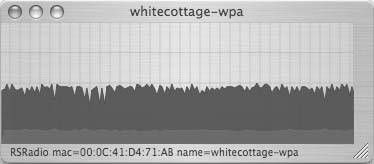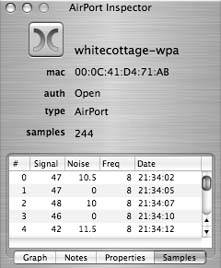Hack 27. Detect Networks on Mac OS X


Find out everything you ever wanted to know about the networks available in your area.
If you are simply looking for any available network, you can usually get by with the built-in AirPort software. However, if you are building your own network or troubleshooting wireless connections, you need much more detail than the standard tools provide. In particular, knowing which networks are in range and which channels they are using can be invaluable when determining where to put your own equipment. Here are two easy-to-use survey tools for Mac OS X that give you a far better idea of what's really going on.
2.6.1. MacStumbler
Sharing nothing but a name with the popular NetStumbler [Hack #24], MacStumbler (http://www.macstumbler.com) is the original network scanner for Mac OS X. It is simple to use, and it provides the details that you are most likely interested in: available networks, the channels they use, and their received signal strength. It also displays received noise, whether WEP is enabled, and a bunch of other useful details, as shown in Figure 2-20.
Figure 2-20. MacStumbler's main screen

Like many Mac OS X apps, MacStumbler is capable of text-to-speech, so it will speak the ESSIDs of networks that it finds as they appear. You can set the preferences to play different sounds when it detects an open network or a WEP network. MacStumbler also has GPS support, and can use GPS devices connected via serial or Bluetooth. With GPS support you can record the latitude and longitude of any access points. This feature is not only for wardriving; it is also very useful when mapping your outdoor wireless network.
Unfortunately, MacStumbler is three years oldthe last update was July 2003and it is showing its age. It supports only the Apple AirPort card, and no external PC Card or USB wireless devices. It also doesn't recognize WPA encrypted networks. Lastly, while MacStumbler does work on the latest 10.4 release of Mac OS X, there is no guarantee of future support, because development seems to have stopped.
2.6.2. iStumbler
A more up-to-date tool is iStumbler (http://istumbler.net). Just fire it up and it will find all available networks for you, complete with a real-time signal and noise meter. It scans Bluetooth and Bonjour networks and reports detailed information on both. It also works with both serial and Bluetooth-connected GPS units. Like MacStumbler, iStumbler supports scanning only when using the built-in AirPort card.
As shown in Figure 2-21, iStumbler's main window packs a lot of information into a small window. The menu on the left offers several monitoring options, including AirPort, Bluetooth, Bonjour, and GPS connections.
The connection monitor, which appears when you join a network listed in the AirPort section of iStumbler, is a nice feature. Figure 2-22 shows a sample window that you can make stay on top of other programs. You can adjust the transparency to your liking, so the monitor is always visible even if you are working on something else.
Figure 2-21. iStumbler's compact display

Figure 2-22. The handy connection monitor

iStumbler lets you join any listed AirPort network directly, without involving the AirPort configuration tools. Likewise, if you are monitoring Bluetooth, you can set up, pair with, or browse available Bluetooth devices. For Bonjour connections, there are options to connect to listed items.
A more powerful item is the Inspector, found in the Edit menu or by pressing Command-I. This is available for all modes in iStumbler, and it provides detailed information on the network or share that is highlighted in the main window. Figure 2-23 shows the detail taken by each sample of an 802.11g network.
2.6.3. Final Thoughts
Both of these tools will find all available Wi-Fi networks quickly and keep historical logs if you need to monitor wireless networks over time. If you need to find all available networks in range, either of these tools is ideal. iStumbler supports newer features of Mac OS X and is the better choice, particularly if you want to examine Bluetooth or Bonjour networks.
MacStumbler and iStumbler work by actively sending out probe requests to all available access points. The access points respond to the probes (as they would for any legitimate wireless client), and this information is then collected, sorted, and displayed by the scanners. Unfortunately, neither of these tools will find "closed" networks, because they don't respond to probe requests.
Figure 2-23. iStumbler Inspector

There is an unfortunate side effect caused by people who choose to hide their networks. Since it isn't easy to tell what channel they are using, it is likely that someone nearby will choose to use the same (or an adjacent) channel for their own network. This causes undesirable interference for everybody. To detect closed networks, you need a passive scanner, such as KisMAC [Hack #28].
Bluetooth, Mobile Phones, and GPS
- Hacks 122: Introduction
- Hack 1. Set Up Bluetooth on Linux
- Hack 2. Set Up Bluetooth on Windows XP
- Hack 3. Connect Mac OS X with a Bluetooth Phone
- Hack 4. Connect Linux with a Bluetooth Phone
- Hack 5. Connect Windows XP with a Bluetooth Phone
- Hack 6. Use Your Treo as a Modem
- Hack 7. Send SMS from a PowerBook
- Hack 8. Remote Control Mac OS X with Bluetooth Phones and PDAs
- Hack 9. Remote Control Linux with a Bluetooth Phone
- Hack 10. Control XMMS with Bluetooth
- Hack 11. Liven Up Parties with a Participatory Slideshow
- Hack 12. Send SMS from Linux
- Hack 13. Remote Control Windows with Bluetooth Phones and PDAs
- Hack 14. Control Your Bluetooth Phone with FMA
- Hack 15. Control Your Computer from Your Palm
- Hack 16. Control Your Home Theater from Your Palm
- Hack 17. Choose a Cellular Data Plan
- Hack 18. Blog from Your Mobile Phone
- Hack 19. Get Google Maps on Your Mobile Phone
- Hack 20. Share Your GPS
- Hack 21. Broadcast Your GPS Position
- Hack 22. Map Wi-Fi Networks with Kismet and GPSd
Network Discovery and Monitoring
- Hacks 2339: Introduction
- Hack 23. Find All Available Wireless Networks
- Hack 24. Discover Networks with NetStumbler
- Hack 25. Detect Networks with Handheld PCs
- Hack 26. Find and Join Wireless Networks with AP Radar
- Hack 27. Detect Networks on Mac OS X
- Hack 28. Scan Passively with KisMAC
- Hack 29. Detect Networks with Kismet
- Hack 30. Monitor Wireless Links in Linux with Wavemon
- Hack 31. Analyze Traffic with Ethereal
- Hack 32. Track 802.11 Frames in Ethereal
- Hack 33. Watch Network Traffic
- Hack 34. grep Your Network
- Hack 35. Check Wi-Fi Network Performance with Qcheck
- Hack 36. Estimate Network Performance
- Hack 37. Get Real-Time Network Stats
- Hack 38. Graph Your Wireless Performance
- Hack 39. Find Radio Manufacturers by MAC
Wireless Security
- Hacks 4051: Introduction
- Hack 40. Stop Moochers from Stealing Your Wi-Fi Bandwidth
- Hack 41. Visualize a Network
- Hack 42. Secure Your Linux Network with WPA
- Hack 43. Control Wireless Access by MAC
- Hack 44. Authenticate Wireless Users
- Hack 45. Forward Ports over SSH
- Hack 46. Proxy Web Traffic over SSH
- Hack 47. Securely Connect Two Networks
- Hack 48. Generate a Tunnel Configuration Automatically
- Hack 49. Poll Wireless Clients
- Hack 50. Interrogate the Network
- Hack 51. Track Wireless Users
Hardware Hacks
- Hacks 5262: Introduction
- Hack 52. Add an External Antenna
- Hack 53. Do-It-Yourself Access Point Hardware
- Hack 54. Boot from a Compact Flash Hard Drive
- Hack 55. Increase the Range of a PowerBook
- Hack 56. Send Power over Your Ethernet
- Hack 57. The NoCat Night Light
- Hack 58. Upgrade the Linksys WET11
- Hack 59. Scan for Wireless Networks Automatically
- Hack 60. Backlight Your Zipit
- Hack 61. Unwire Your Pistol Mouse
- Hack 62. Mobilize Your WRT54G with the WiFiCar
Software Hacks
- Hacks 6382: Introduction
- Hack 63. Build Your Own Access Point with Linux
- Hack 64. Bridge Your Linux AP
- Hack 65. Protect Your Bridge with a Firewall
- Hack 66. Filter MAC with HostAP and Madwifi
- Hack 67. Upgrade Your Wireless Router
- Hack 68. Set Up an OLSR Mesh Network
- Hack 69. Extend Your Wireless Network with WDS
- Hack 70. Pebble
- Hack 71. Wall Off Your Wireless
- Hack 72. Run Your Mac as an Access Point
- Hack 73. Run Linux on the Zipit Wireless Messenger
- Hack 74. Capture Wireless Users with NoCatAuth
- Hack 75. Capture Wireless Users on a Small Scale
- Hack 76. Build an Online Community in Your Offline Neighborhood
- Hack 77. Manage Multiple AirPort Base Stations
- Hack 78. Advertise Bonjour Services in Linux
- Hack 79. Advertise Any Service with Bonjour in Mac OS X
- Hack 80. Redirect Brought to you by Bonjour Ads
- Hack 81. Use a Windows-Only Wireless Card in Linux
- Hack 82. Use Your Orinoco Card with Hermes AP
Do-It-Yourself Antennas
- Hacks 8393: Introduction
- Hack 83. Make a Deep Dish Cylindrical Parabolic Reflector
- Hack 84. Spider Omni Antenna
- Hack 85. Pringles Can Waveguide
- Hack 86. Pirouette Can Waveguide
- Hack 87. Primestar Dish with Waveguide Feed
- Hack 88. Primestar Dish with Biquad Feed
- Hack 89. Cut a Cable Omni Antenna
- Hack 90. Build a Slotted Waveguide Antenna
- Hack 91. The Passive Repeater
- Hack 92. Determine Your Antenna Gain
- Hack 93. Build Cheap, Effective Roof Mounts
Wireless Network Design
- Hacks 94100: Introduction
- Hack 94. Analyze Elevation Profiles for Better Long-Range Wireless Networking
- Hack 95. Build a Wireless Network for the Large House
- Hack 96. Establish Line of Sight
- Hack 97. Calculate the Link Budget
- Hack 98. Align Antennas at Long Distances
- Hack 99. Slow Down to Speed Up
- Hack 100. Take Advantage of Antenna Polarization
Appendix A. Wireless Standards
- Appendix A. Wireless Standards
- Section A.1. 802.11: The Mother of All IEEE Wireless Ethernet
- Section A.2. 802.11a: The Betamax of the 802.11 Family
- Section A.3. 802.11b: The De Facto Standard
- Section A.4. 802.11g: Like 802.11b, only Faster
- Section A.5. 802.16: WiMAX Long Distance Wireless Infrastructure
- Section A.6. Bluetooth: Cable Replacement for Devices
- Section A.7. 900 MHz: Low Speed, Better Coverage
- Section A.8. CDPD, 1xRTT, and GPRS: Cellular Data Networks
- Section A.9. FRS and GMRS: Super Walkie-Talkies
- Section A.10. 802.1x: Port Security for Network Communications
- Section A.11. WPA & 802.11i
- Section A.12. BSS Versus IBSS
Appendix B. Wireless Hardware Guide
EAN: 2147483647
Pages: 178
